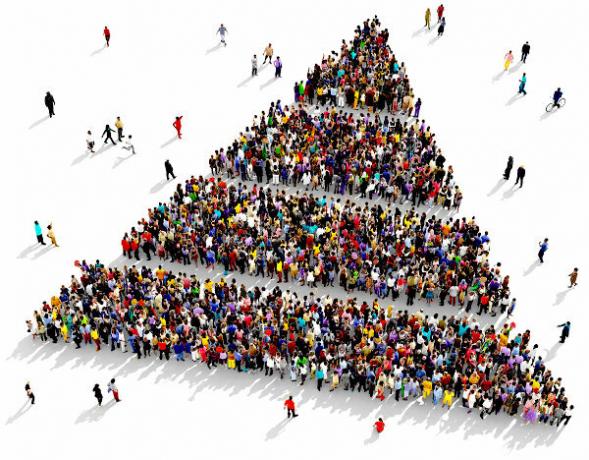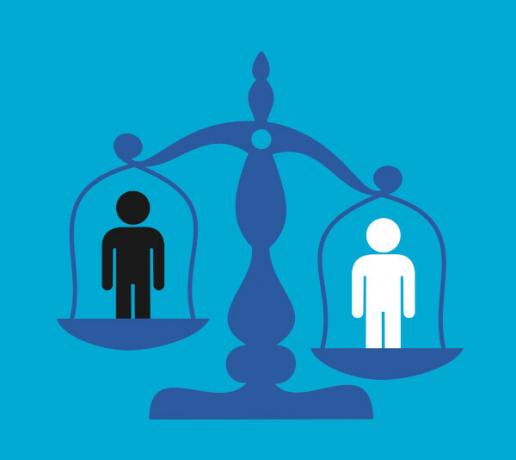THE social mobility is the change of position within the hierarchical structure of a society. This sociological concept as well as the sociology as a science they were developed within modern industrial society, complexified in a continuous expansion of professions and stratified into social classes.
Therefore, social mobility is a phenomenon of modern society, hierarchized in classes, in turn defined by financial and professional status. Mobility consists of change of position from one class to another.
THE upward mobility Its main path is to increase the length of formal study, which allows individuals from poor families to get jobs that are better paid than their ancestors. THE downward mobility its main path is the loss of income, it is a typical process of economic crises in which impoverishment leads families to migrate to Social classes with the worst positions in the social pyramid.
Read too: Brazilian culture: from diversity to inequality

What is social mobility?
As defined by sociologist Anthony Giddens, social mobility is the “displacement of individuals and groups between different socioeconomic positions”. This movement of individuals or families takes place within the social class system, structured according to socio-professional categories.
Social mobility can occur between individuals of the same generation (intragenerational) or between individuals from different generations (intergenerational), it can be ascendant, that is, to be a positive change of position in the hierarchy, or to be downward, produce loss of position and status. The possibility of moving within the social structure reaffirms the ideals of the bourgeois revolution: equality, fraternity and freedom.
Do not stop now... There's more after the advertising ;)
THE social stratification it is structured around multiple variables. The main ones are income and occupation, but as pointed out Max Weber, in addition to the economic factor, the status (prestige) and the power (capacity of influence) also make up this arrangement and contribute to the ranking of positions. Other factors that affect income affect social mobility, such as gender, age, ethnicity, education. Inequality is the greatest impediment to social mobility. According to research by Wilkinson and Pickett (2009), the bigger the social inequality in a country, the lower will be the social mobility.
According to the report of the World Economic Forum, the promoting social mobility requires the joint effort of governments and companies.. Governments have an equalizing role in providing access to opportunity for all citizens:
- develop a fair tax collection model that is progressive, focusing on income rather than production and consumption;
- implement policies with a social emphasis, expanding access to education and lifelong learning, and not only in the early years, and to the social protection of workers in a context of intense changes. technological.
According to this report, companies that place a purpose set above profit target perform better in the long run. Qualifying employees, paying fair wages and fighting the pay gap between men and women contribute for more stable economic environments and greater trust between entrepreneurs and customers, growing bases of consumers.
The report concludes that updating business practices and state action is necessary for expand social mobility and reduce inequalities, promoting sustainable economic growth and equitable.
See more: Domination for Max Weber - acceptance and subordination of individuals to the power exercised by someone else
Historical context and social mobility
Feudal society preceded modern society. At the feudalism medieval, societies were estates, that is, structured in estates:
- King
- nobles
- clergy
- people
Each group had specific rights and duties, with the first three enjoying material privileges and symbolic honors that the latter did not have. In these societies, the social mobility was extremely low, not to say null, that is, whoever was born a nobleman would die a nobleman, whoever was born a commoner would die a commoner.
The social hierarchy was considered natural and the result of the divine will, therefore, immutable. Kings granted land to nobles, who in turn offered peasants work in the fields in exchange for protection and food. The clergy was the religious authority, the king the political authority, and the nobility the military authority.
At low middle age, there were changes that prepared the bases for building a new structure of society. O renaissance, O humanism, the discovery of new sea routes, the intensification of trade and the use of currency as an exchange value caused changes in mentality and behavior, in addition to having allowed the emergence of a new social group: a bourgeoisie.
This was formed by merchants as well as former serfs who left peasant life and went to the villages in search of better subsistence conditions. This is the process of social mobility that, among other factors, created conditions for the emergence of modern societies.
Modern societies, which developed with industrial capitalism and the formation of bureaucratic states, are structured in strata, that is, social classes. In them, a change in socioeconomic position is possible. The social hierarchy exists and is rigid, but it is not immutable.
The change in status within this defined structure is mainly due to the extension of study time, professional change, and modification in the income pattern. This change is possible, especially when there are government policies that promote these opportunities to citizens.

Types of social mobility
There are two types of social mobility: horizontal and vertical.
horizontal social mobility
implies change of occupation without changing social class, it's like changing jobs and staying in the same income bracket. It also covers changing position within a group that checks authority and prestige in the symbolic field, but does not change the economic condition.
An example of this occurs in an ecclesial community, where the most dedicated members become volunteer assistants to the leader. religious and therefore receive an honor through a title that differentiates them from others, such as deacons in communities Christians.
vertical social mobility
in turn implies change in socioeconomic position, therefore, involves not only the symbolic and social dimension, but also the purchasing power. In a modern industrial society, stratified according to professions and with social classes defined according to income, vertical mobility occurs when, through professional ascent, the individual is able to move from one income bracket to another.
For example, an individual from class C who enters Higher Education graduates, becomes a liberal professional and migrates to class B. The main path to achieve vertical social mobility is formal education.
Vertical social mobility can be classified as ascending and descending. THE mobilityascendant it occurs when a person moves to a higher position in the socioeconomic pyramid. already the mobilitydownward it occurs when someone loses positions and moves to an inferior social position.
Factors influencing social mobility
The main factor for measuring social mobility is the income. The expansion or destitution of wealth is the main trigger for class change up or down. The second factor, linked to the first, is the occupation. Modern societies are characterized by complexity. For Durkheim, the more complex a society is, the more work functions it will have. The emergence of new trades in the production process is a constant in these societies.
In addition, the structuring of the world of work is the basis for the social configuration as a whole, from human relations, to State action and even the division of territorial space, the disposition of neighborhoods, and access to economic centers and services. Therefore, the profession occupies a central place in the stratification of these societies., with the most valued professions generally being better paid and at the top of the hierarchy.
The third factor influencing social mobility is the formal education. The higher the level of education, the greater the chance of becoming a professional in activities with greater social prestige and with better salaries.
Also access: Social status - position each group occupies in social dynamics

Social mobility in Brazil
Brazil is the second most unequal country in the world. The more unequal a country is, the lower its social mobility, therefore, social mobility in Brazil is low. In Brazilian sociology, Celi Scalon is a reference in the study of intergenerational mobility and social stratification in Brazil and how it is distributed territorially (spatial segregation) and is justified and recognized.
A study, carried out in the 2000s, that analyzed mobility in Brazil between 1988 and 1996, signaled a small growth in intergenerational mobility in this period, mainly due to migration to urban areas. However, it was a short distance mobility, that is, it did not change the pattern of social stratification in the country, since the labor market in Brazil is characterized by a high rigidity and the chances of progression through the professional trajectory are limited.
The wealthy strata sustained their position over time, while for salaried strata there was a worsens in professional careers and reduced possibilities for advancement, especially for women. The conclusion is that there was no significant change in intra and intergenerational mobility patterns and on inequality in Brazil during this period.
According to the 2020 World Economic Forum report, in a ranking of social mobility, among 82 countries, Brazil is in 60th position. Brazil's score was 52.1 on a scale from 0 to 100, with the worst index in the country is in the variable "fair distribution of wages". The Global Social Mobility Index considers factors such as:
- Job opportunities
- work conditions
- fair distribution of wages
- social protection
- access to health and education
- access to technology and lifelong learning
- quality and equity of education
- inclusive institutions
This report also measures social mobility when calculating how many generations does it take for a low-income family to reach the country's average income. In Denmark, one of the countries that lead the ranking of social mobility, low-income families take two generations to reach the average income. In Brazil, there are nine generations. The report points out the poor design of public policies as responsible for the persistence of inequality and low social mobility.
By Milka de Oliveira Rezende
Professor of Sociology


